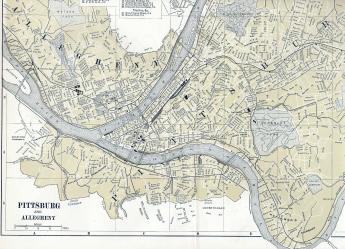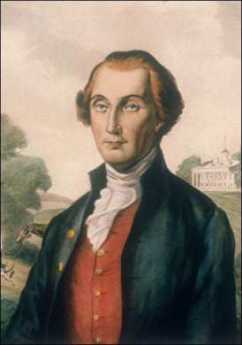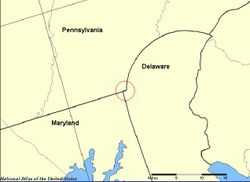Related Topics
Albert Gallatin
A magnificent but largely forgotten man.
Virginia Invades Pennsylvania

|
| Map of Pittsburg |
Pittsburgh is situated at a water gap, where a prehistoric North-South river broke through the mountain to the West. Thus, the southerly Monongahela river joined the northerly Allegheny to form the Ohio river at the "Golden Triangle". Virginian explorers saw the Monongahela as their path to the mid-West, the French in Canada saw the Allegheny as their path from the Great Lakes to the Mississippi, while William Penn had an awkward charter saying he owned the whole territory. To make matters worse, the region was largely settled by semi-barbarian Scotch-Irish squatters, while the equally fierce Indian tribes were pretty outraged by the white men. Benjamin Franklin added his bit to uproar by buying the territory from the Iroquois at the 1754 Albany Conference, when it belonged to the Delaware tribe, who promptly became the main exterminators of General Braddock's army. Lord Dunmore also bought the Ohio territory from the Iroquois, in spite of the fact that it traditionally belonged to the Shawnees. The whole region was a seething cauldron of massacres and assassinations, betrayals and vengeance. Not exactly a place to welcome pacifist Quaker governance.

|
| Young George Washington |
It would be interesting to know George Washington's later thoughts about this region since he was the young officer who started the French and Indian War in 1753. The Governor of Virginia had learned the French were fortifying Fort Duquesne at the forks of the Ohio and sent Washington to warn them to desist. He barely escaped with his life, and soon accompanied General Braddock's English troops to their own disaster in 1755. In 1758 the British sent General Forbes with a British army to wipe out Fort Duquesne, which he did, establishing Fort Pitt on the ashes. Fort Pitt somehow remained under the control of -- Virginia -- until 1777.

|
| Delaware River |
The Penn proprietors were vigilant, but patient when they had to be. Presumably through influence with the British crown, the Penns gave their consent to the Forbes expedition only on condition their ownership rights were recognized. Their argument was a difficult one to maintain in the face of military realities, since their charter read that the western boundary of Pennsylvania was to be five degrees west of the Delaware River, a rather vague concept in the wilderness of Appalachia. It was maintained that such a boundary would naturally parallel the twists and turns of the Delaware, at a distance of several hundred miles west. Such a preposterous boundary was soon abandoned for the cubist idea of several straight lines with bends at major levels of the Delaware River. With all disputants rather befuddled, it was finally established that any possible variation of language and interpretation would still put the boundary at least six miles west of the forks of the Ohio. Seeing the main point of the sophistry was lost in any event, Virginia gave up.
It might be possible to be sympathetic with Virginia's claim, except for Lord Dunmore the Governor. After all, Virginia had shed blood for the area, surveyed it, built roads, and persuaded the British Ministry to support them militarily. The Pennsylvanians only had a piece of parchment, carelessly engraved with an unworkable depiction of vague boundaries in the woods which totally ignored the most important natural landmark. But Lord Dunmore was too clever by half.
It would appear that his scheme was to make the region uninhabitable by stirring up the Indians and settlers into ferocious massacres. With these competing claims eliminated, it would be far easier to negotiate with other competitive claimants. Virginia was by far the largest of the thirteen colonies, and Pennsylvania was notoriously the most unwilling to meet force with force. It would be interesting to see studies of the inside pressures and negotiations which eventually made Virginia back off. But it seems safe to believe that the necessity for the colonies to unite in their common struggle for independence was in one form or another, the definitive force.
At any rate, at the end of a long career, in 1794 President George Washington personally led an army into Pennsylvania's Appalachia to suppress the Whiskey Rebellion at a town called Monongahela. It would be immensely revealing to know what his thoughts and reflections were, as he jiggled along on his horse.
Originally published: Wednesday, September 27, 2006; most-recently modified: Wednesday, May 29, 2019